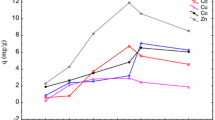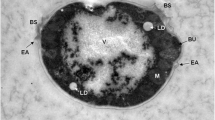Abstract
The ionic composition of the of the intracellular content of the alcohol yeast Saccharomyces cerevisiae R. 1039 biomass was studied for confirmation of their use perspectiveness as a mediator to enable the management the mineral content of food in the manufacture of food and feed additives. The ionic composition of the obtained extracts were identified using the method of capillary electrophoresis. It is found that the quantitative ion content in the cell extracts depends on the concentration of the nutrient medium. When the yeast S. cerevisiae R. 1039 was cultivated on the medium with the soluble solids concentration of 30%, the intracellular ion content in the extracts was 1.3 times higher than when the yeast was cultivated on 12% wort by increasing the concentration of chlorides, sulfates, formates, potassium ions, and calcium. The yield of the yeast S. cerevisiae R. 1039 biomass increased 1.6 times per unit of volume of the medium with increase of the soluble solids concentrations from 12% to 30%.
Similar content being viewed by others
References
Spirichev, V.B., Scientific principles of enriching food with micronutrients, Vashe Pitan., 2000, no. 4, pp. 13–19.
Serba, E.M. and Polyakov, V.A., Biotechnological foundations of complex processing of grain raw materials and secondary bioresources into ethanol and protein- amino acid additions, in Monografiya (Monograph), Moscow: VNIIPBT, 2015.
Rimareva, L.V., Teoreticheskie i prakticheskie osnovy biotekhnologii drozhzhei (Theoretical and Practical Bases of Yeast Biotechnology), Moscow: DeLi print, 2010.
Rimareva, L.V., Overchenko, M.B., Ignatova, N.I., Shelekhova, N.V., Serba, E.M., Martynenko, N.N., and Krivova, A.Yu., Influence of enzyme complexes on metabolism of alcohol yeast and accumulation of inorganic ions in concentrated grain wort, Vestn. Ross. S-kh. Nauki, 2016, no. 3, pp. 28–31.
Dickinson, J.R. and Scheweizer, M., Stress responses, in The Metabolism and Molecular Physiology of Saccharomyces cerevisiae, New York: Taylor & Francis, 1999.
Nevoigt, E. and Stahl, U, Yeast, New York: Cold Spring Harbor Laboratory Press, 1996, vol. 12, pp. 1331–1337.
Privalova, E.A., Tiguntseva, N.P., Adamovich, S.N., Mirskov, R.G., and Mirskova, A.N., Tris-(2-hydroxyethyl) ammonium ionic liquids are new biostimulators of growth of alcohol yeast Saccharomyces cerevisiae, Vestn. Irkutsk. Gos. Tekh. Univ., 2015, no. 11, pp. 136–141.
Patent RFNo. 2378366, kl. C12N1/16; C12P7/06, Byul., no. 1, 2010.
GOST (State Standard) R 55761-2013: Kneading, Wort, and Brew from Food Raw Materials. Determination of the Mass Concentration of Cations and Anions of Inorganic and Organic Acids by Capillary Electrophoresis, 2014.
Author information
Authors and Affiliations
Corresponding author
Additional information
Original Russian Text © L.V. Rimareva, M.B. Overchenko, N.I. Ignatova, N.V. Shelekhova, E.M. Serba, A.Yu. Krivova, 2017, published in Rossiiskaya Sel’skokhozyaistvennaya Nauka, 2017, No. 1, pp. 51–54.
About this article
Cite this article
Rimareva, L.V., Overchenko, M.B., Ignatova, N.I. et al. Study of intracellular ion composition of yeast Saccharomyces cerevisiae biomass. Russ. Agricult. Sci. 43, 186–189 (2017). https://doi.org/10.3103/S106836741702015X
Received:
Published:
Issue Date:
DOI: https://doi.org/10.3103/S106836741702015X




